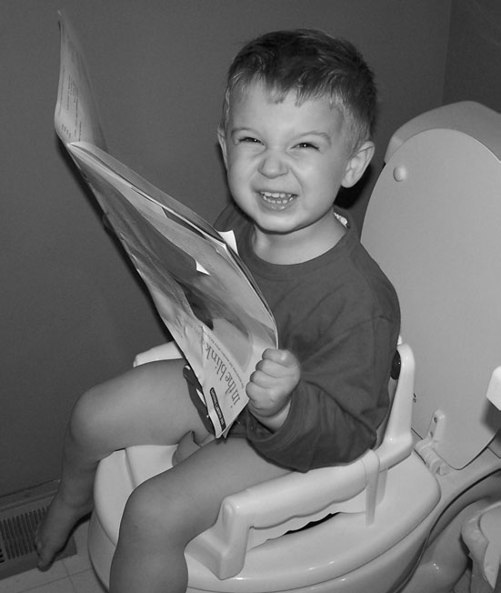The No-cry Potty Training Solution (8 page)
Read The No-cry Potty Training Solution Online
Authors: Elizabeth Pantley

These two magic factors will set the pace for potty training. These can make the toilet training journey a stressful, unpleasant event, or they can ensure that it is a pleasant, successful process.
These two factors can make your child miserable, or they can make him happy. They can make any
approach a disappointing disaster, or they can make almost any toilet training method work beautifully.
What are these Magic Two? The teacher’s attitude and the teacher’s level of patience.
Allow me to repeat that idea for you, just to be certain you grasp this critical concept. The two magic factors that will set the pace for potty training are your attitude and your patience.
You’ll note that I didn’t mention anything about the student! That’s because children learn things from their parents and other people in their life—that’s what they do. And children are like little sponges. Children are always watching others, especially the adults in their life.
They pick up cues from others about how they should respond in various situations; no matter if it’s the first time on a horse, the first taste of a papaya, or the first sit on a potty chair, your child will be learning from you.

52
The No-Cry Potty Training Solution
So regardless of where your child is in the readiness department, and no matter what approach you decide to take, make sure that your Magic Two are in the right place before you begin.
The Two Magic Indicators
for Toilet Training Success
• The teacher’s positive and supportive attitude.
• The teacher’s kind and understanding patience.
Supplies You’ll Need
It’s best to have everything you need on hand before starting the potty training process. The following information will help you create your own shopping list for supplies.
A Potty Chair or Potty Seat
A regular adult toilet doesn’t fit a child very well. It’s hard to climb up to it, and then a child has to balance and hold himself up while seated, making elimination more difficult. The hole is usually large enough for a tyke to fall through, into the water, which can be a frightening experience for a child. A better choice for a new trainee is a child-sized potty or an adapter seat insert accompanied by a sturdy footstool.
There are many, many different types available, so shop around. A child-sized chair or seat insert is important to help bring the toilet down to your child’s size and make it friendly, safe, and manageable. Nearly any

It’s Potty Time! Setting Up
53
Bailey, two years old
type will work, and the choice is yours. (See the chart that follows for a comparison.)
Some potty seats come with a high, removable splash guard created to prevent a new trainee from splattering the bathroom. While the intention for these is good and they can serve the purpose, splash guards also present an injury hazard. Many children lose their balance

54
The No-Cry Potty Training Solution
Comparing the Potty Choices
Freestanding Potty Chair
Pros
• It is small in size, easy to use, and nonthreatening.
• It is designed specifically for a child’s small body.
• It allows the child to plant his feet on the floor.
• It comes in bright colors and child-friendly designs.
• It is portable—can be moved from room to room or taken on trips.
• It promotes independence—can be used by a child on his own.
Cons
• The bowl must be cleaned out after each use.
• The child will have to transition to a regular toilet later.
• The child may still need a toilet seat insert when moving up to the big toilet.
• When you are away from home, you must bring the potty or your child must adjust to the differences in equipment.
• Portability can make it too much like a toy (leaving it open to misuse): a toy box? a hat?
• You must purchase one for each bathroom or move it from one bathroom to another.
Toilet Seat Insert (Adapter/Potty Seat)
Pros
• The child doesn’t have to adjust from a child seat to an adult toilet.
It’s Potty Time! Setting Up
55
• You will not have a potty seat on your bathroom floor.
• There is no potty chair bowl to clean out.
Cons
• It is not child-sized.
• The child must use a stool or have an adult’s help to climb up.
• The child’s feet will dangle, so a footstool (where the child can place her feet) is necessary.
• Adults must contend with the insert when they use the toilet.
• The child must be supervised by an adult throughout all uses.
• You must purchase one for each bathroom or move it from one bathroom to another.
Adult Toilet Seat
Pros
• There is no learning adjustment from seat to seat.
• The child can use any toilet once he learns to use the one at home.
Cons
• It is not as enticing to a child as a colorful child’s potty chair.
• It is oversized for a child, which can be intimidating.
• The child might fall off the seat or into the water.
• The child will need a footstool to plant feet.
• The child must be supervised by an adult throughout all uses.
(continued)
56
The No-Cry Potty Training Solution
Comparing the Potty Choices
, continued
Potty Chair/Potty Seat Buying Checklist
9 The seat size matches the child’s body size.
9 The splash guard is low, padded, or removable.
9 The base is stable and sturdy.
9 The bowl is easy to remove for cleaning.
9 The seat is comfortable, perhaps cushioned.
9 It is portable for moving from room to room or for travel.
9 It has an appealing design.
9 It has good functionality.
climbing over the guard and fall or might get bruised in a very delicate area when climbing on or off the potty.
Either of these situations can cause a fear of the potty and create a major setback. Better to teach your little boy to hold his penis down to pee and your little girl to relax and lean forward a bit, instead of backward, which will prevent any splashing.
If you opt to use an insert that fits into the regular toilet, you’ll need to get one to fit your toilet seat, which may be round or elongated. You will also need a stool.
This serves two purposes: to help your child climb up to the seat and to use as a platform for his feet. It is much harder to control the sphincter muscles when feet are dangling in the air.
If your child spends time in two different homes, or if the bathrooms in your home are far apart from each other, buy several of the same potty to keep things easy and consistent.
It’s Potty Time! Setting Up
57
Consider your child’s personality in advance of purchasing a potty for him. Do you think he’ll be more accepting of the potty if he goes with you to the store to pick it out? If so, go ahead and shop together. Take one out of the box and let him sit on it in the store. Or perhaps your child would like it better if you wrapped one up in colorful wrapping paper and presented it to him with a flourish. Either choice is fine.
A Portable Potty Seat
No matter what kind of toilet arrangement you have at home, it’s likely that your child will be facing a different situation when she’s away. It’s often helpful to purchase a seat adjuster that you can keep in your purse or diaper bag. This is a folding insert that you can use when you’re away from home. It adapts bigger toilets to your child’s size and makes them a little more familiar, which is important for new trainees who are comfortable with a little potty at home but might be overwhelmed or frightened by a big toilet and stall in a public place.
It’s a good idea to practice using this portable adjuster at home a few times before you go out. Otherwise it’s just as unfamiliar as the strange toilet you are placing it upon.
Training Pants
Get a supply of a dozen or more cotton training pants or a couple of boxes of disposable pull-up pants. These will herald the new stage of development for your child and be a clear signal that something new has begun.
58
The No-Cry Potty Training Solution
Thick, absorbent training pants (rather than regular underwear) are great for new trainees. They will absorb most or all of your child’s accidents (which will be many at first) and protect your floors and furniture.
Disposable pull-up pants, which contain accidents, are a popular choice for new trainees. Be aware, however, that the disposables can backfire (so to speak).
Because they may feel like diapers to your child, your child may treat them as such. Look into one of the new varieties that are a little less unwieldy and have a get-wet liner that allows your child to feel the moisture, which will help him to identify, and hopefully avoid, that wet feeling.
Children can move on to less bulky and more attractive underwear once they start to have some success. In addition, the switch from training pants to big girl or big boy pants can be motivating and will be something special your child can look forward to.
Tricks and Treats
Lots of interesting accessories are available for potty training: musical potty chairs, bull’s-eye targets, toddler-sized urinals, dissolving floaters, dolls that wet, and prize charts are some examples. None of these are necessary, but lots of them are fun, and some can motivate your child and move the process happily along.
Choose your tricks thoughtfully, though, because some can be more of a distraction than a help. Several parents told me of using musical potties and having their children jump up midstream to see what was going on back there!
It’s Potty Time! Setting Up
59
If something catches your eye and you think it will make the process more fun for your child, go ahead and try it.
Decide Where to Put the Potty
If you are using a potty chair instead of an insert, you can place it wherever you’d like. Many families put the potty in the bathroom right next to the big toilet. The advantage to this is that your child gets used to the location, and it makes for easy dumping and cleaning. It also helps a child connect the potty with the action, because other members of the family use the toilet in the same room.
The disadvantage to keeping your child’s potty near the toilet is that if your bathroom is far away from the places in your home where your child spends his time, then you may have a number of accidents at first while he’s on the way to the bathroom. This will pass, however, as your child gets used to reading his body signals.
Some families choose to keep the potty chair in the room where the child spends his time. During the day it can be kept in the kitchen. If you do this, it’s a good idea to create a little potty nook or corner to allow a child some privacy and to reinforce the idea that this isn’t a public event. During the bedtime routine and overnight, the potty can be kept in the bedroom for easy access, if you’d like. The advantage to a movable potty is that your child is more likely to get to the pot in time. The disadvantage is that at some point you’ll need to transfer your child’s toileting to the bathroom,